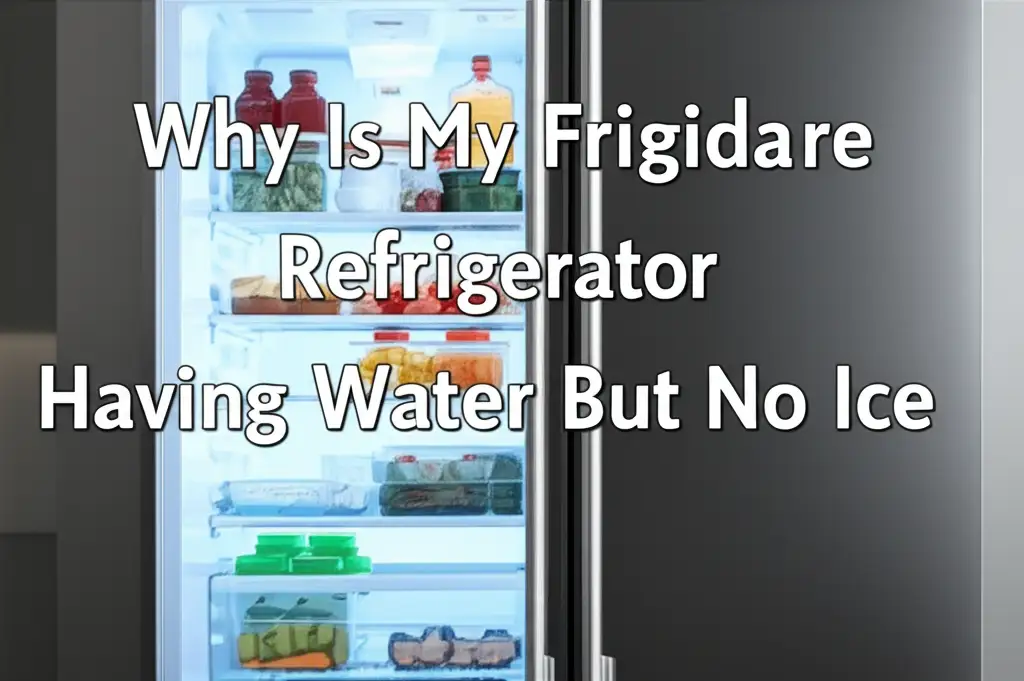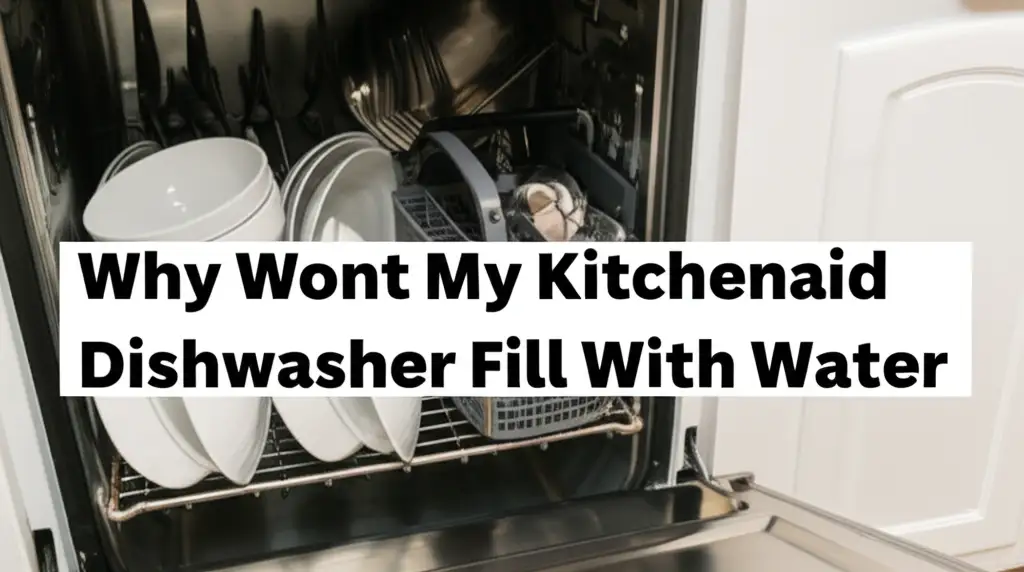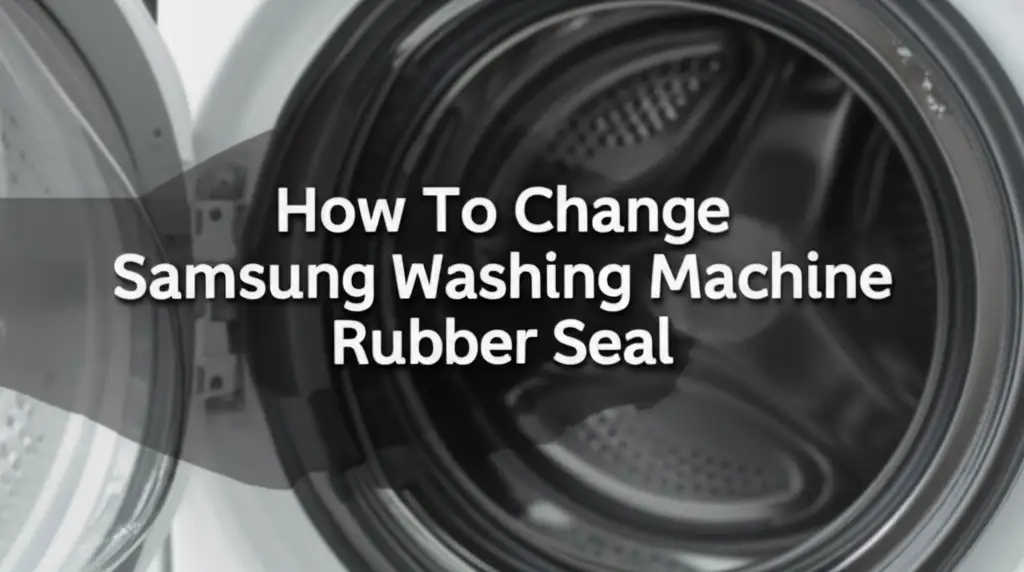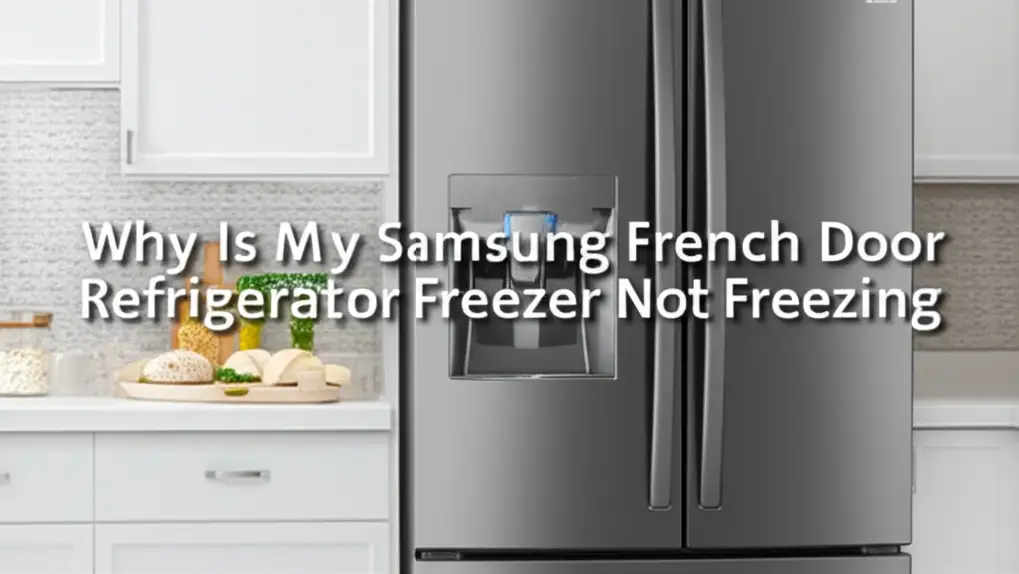· Katria Melrose · Appliance Repair · 17 min read
Why Is My Frigidaire Refrigerator Having Water But No Ice

Why Is My Frigidaire Refrigerator Having Water But No Ice
It is certainly frustrating when your Frigidaire refrigerator provides water but refuses to make ice. You rely on that crisp, cold ice for drinks, especially on a warm day. When the water dispenser works perfectly, it can seem confusing why the ice maker has stopped. This common issue often points to specific problems within the ice production system, rather than a general water supply problem. I understand how inconvenient this situation can be in your home.
This article will guide you through the typical reasons your Frigidaire ice maker might be struggling. We will explore various components like the water inlet valve, water filter, and the ice maker assembly itself. You will learn clear troubleshooting steps to diagnose the problem. We will also cover practical solutions to get your ice maker working again. Our aim is to help you restore ice production and enjoy cold beverages without a hitch.
Takeaway
If your Frigidaire refrigerator delivers water but no ice, here are the key steps to follow:
- Check the water supply: Ensure the water line is connected, the shut-off valve is open, and water pressure is adequate.
- Replace the water filter: A clogged filter is a very common cause of reduced water flow to the ice maker.
- Inspect the water inlet valve: This valve might be faulty, preventing water from entering the ice maker mold.
- Examine the ice maker assembly: Look for mechanical issues, frozen components, or a faulty module.
- Verify freezer temperature: The freezer must be cold enough (0-5°F) for ice to form properly.
Your Frigidaire refrigerator has water but no ice usually because of a blockage in the water line to the ice maker, a faulty water inlet valve, a clogged water filter, or a mechanical problem with the ice maker assembly itself. The freezer temperature might also be too warm for proper ice formation.
Understanding Frigidaire Ice Production: Water Flow and Freezing
Your Frigidaire refrigerator’s ice maker works through a precise series of steps to give you those perfect cubes. First, water flows from your home’s main supply through a small water line to the refrigerator. This water then passes through a water filter, which cleans it before it reaches the ice maker. The water filter removes impurities, ensuring your ice tastes clean and fresh.
Once filtered, a water inlet valve opens to allow a measured amount of water into the ice maker’s mold. This valve is crucial; it controls the flow of water to the ice maker. The water sits in the ice maker mold while the freezer temperature cools it down. This process typically requires the freezer to be at or below 0 degrees Fahrenheit (-18 degrees Celsius).
After the water freezes into cubes, the ice maker assembly begins its harvest cycle. A heating element slightly warms the mold to loosen the ice. Then, a motor turns a tray to eject the ice cubes into the ice bucket. Finally, a bail arm or optical sensor detects if the bucket is full. If it is full, the ice maker stops production until more ice is needed. This entire process repeats automatically to keep your ice supply ready. If any part of this system breaks, you might find your Frigidaire refrigerator having water but no ice.
Diagnosing Common Frigidaire Ice Maker Problems
When your Frigidaire refrigerator is making water but no ice, several components could be at fault. We start by checking the simplest issues first. Many people overlook these simple checks. The problem often lies with the water delivery to the ice maker or the ice maker’s ability to freeze or eject ice.
One common issue is a clogged water filter. Your refrigerator’s water filter removes sediment and contaminants from the water. Over time, it can become clogged, restricting water flow to the ice maker. This restriction might not affect the main water dispenser as much, but it can significantly reduce the amount of water reaching the ice maker mold. You might notice slower ice production or no ice at all. Replacing the filter is a quick and easy first step to troubleshoot the problem.
Another frequent culprit is the water inlet valve. This electrical valve opens to allow water into the ice maker. If it is faulty, it may not open fully or at all, preventing water from reaching the ice mold. You might hear a buzzing sound from the back of the refrigerator if the valve is trying to open but failing. This valve is critical for the ice maker’s operation. A simple test with a multimeter can determine if it is receiving power and if it is opening correctly. Identifying the exact problem helps you fix it faster.
Initial Checks for Ice Production
Before diving into complex repairs, perform these quick checks. They often reveal the cause of the problem. These steps are easy to do and do not require special tools.
- Confirm Water Supply: First, ensure the water supply line to your refrigerator is fully open. This line usually connects to a cold water pipe under your sink or in the basement. If this valve is closed or partially closed, the ice maker will not receive enough water.
- Check the Ice Maker Bail Arm/Sensor: Many ice makers have a metal bail arm or an optical sensor. This arm or sensor detects when the ice bucket is full. Make sure the arm is in the down position. If it is stuck in the up position, or if something blocks the optical sensor, the ice maker thinks the bucket is full and stops producing ice. Gently move the arm up and down to ensure it moves freely. Clean any debris from the optical sensors if your model has them.
- Look for Frozen Water in the Mold: Sometimes, water freezes in the ice maker mold before it can be ejected. This can prevent new water from entering. If you see ice stuck in the mold, gently melt it with a hairdryer on a low setting or unplug the refrigerator for a few hours to allow a complete defrost. This can often reset the system.
Troubleshooting a Clogged Water Line or Filter
A common reason your Frigidaire refrigerator has water but no ice is a problem with the water delivery system. This often involves the water line or the water filter. I have seen many cases where these simple issues are the root cause. Addressing them first can save you time and effort.
Your refrigerator’s water filter plays a vital role. It cleans the water that goes to both your dispenser and your ice maker. Over time, filters collect sediment and minerals, causing them to clog. A clogged filter restricts water flow, meaning not enough water reaches the ice maker to form cubes. Even if your water dispenser still works, the lower pressure might prevent the ice maker from filling properly. Most manufacturers recommend changing your water filter every six months. If it has been longer than that, a new filter is a good first step. I recommend using genuine Frigidaire filters for the best performance.
The water supply line itself can also become an issue. This thin tube carries water from your home’s main line to the refrigerator. It can get kinks, especially if the refrigerator was recently moved. A kink in the line will drastically reduce water flow. You should gently pull the refrigerator away from the wall and inspect the water line behind it. Look for any bends or crimps. Straightening the line often restores water flow. Sometimes, the line can also become frozen, especially if the refrigerator is in a cold garage or if the line passes near a cold air vent. If you suspect a frozen line, unplug the refrigerator and let it sit for a few hours to thaw. For detailed cleaning of the water line, refer to our guide on how to clean refrigerator ice maker water line.
Finally, check the small tube that delivers water directly into the ice maker mold. This fill tube, located just above the ice maker, can sometimes freeze up. If ice forms inside this tube, it blocks the flow of water. This happens if the water inlet valve leaks slightly or if the freezer temperature fluctuates. You can carefully clear this blockage using a hairdryer on a low setting, or by turning off the refrigerator to allow it to defrost naturally. Regular maintenance helps keep these components working correctly. Cleaning the refrigerator water dispenser can also help maintain overall water quality.
Addressing a Faulty Frigidaire Water Inlet Valve
When your Frigidaire refrigerator has water but no ice, the water inlet valve is a prime suspect. This component controls the flow of water from your home’s supply line into the refrigerator’s ice maker and water dispenser. It is an electrically operated valve, meaning it needs power to open and allow water through. If this valve fails, water simply cannot reach the ice maker.
You can often find the water inlet valve on the back of your refrigerator, near the bottom. It usually has two solenoids, one for the water dispenser and one for the ice maker. If your water dispenser works, but the ice maker does not, it suggests the solenoid for the ice maker might be faulty. This means the valve is opening for the dispenser but not for the ice maker. You might hear a faint buzzing sound from the valve when the ice maker tries to fill, but no water actually flows. This sound indicates the valve is trying to operate but cannot open fully.
Testing the water inlet valve requires a multimeter. First, unplug your refrigerator for safety. Then, locate the valve and disconnect its electrical connectors. Set your multimeter to read ohms (resistance). Place the probes on the terminals of the solenoid for the ice maker. You should get a reading, typically between 200 and 500 ohms, depending on the model. If you get no reading, or an extremely high reading, the solenoid is likely defective.
Even if the solenoid shows good resistance, the valve can still be faulty. Sometimes, mineral deposits or debris can clog the valve, preventing water from passing through. The valve body itself can also crack or leak, leading to poor water flow. If you suspect the valve is clogged or mechanically stuck, replacing the entire water inlet valve assembly is usually the best solution. It ensures a new, fully functional part controls the water supply to your ice maker. This step often resolves the “water but no ice” issue completely.
Fixing a Defective Frigidaire Ice Maker Assembly
If your Frigidaire refrigerator has water but no ice, and you have ruled out water supply issues, the problem often lies with the ice maker assembly itself. This is the unit that actually forms and ejects the ice. Components within the assembly can fail, preventing it from completing its cycle. I have seen many instances where a simple reset or a component replacement within this unit brings the ice maker back to life.
First, check the ice maker’s control arm or sensor. Many ice makers use a wire arm that drops down to sense if the ice bucket is full. If this arm is stuck in the up position, the ice maker believes the bucket is full and will not produce ice. Gently lower the arm to its operating position. Some newer Frigidaire models use an optical sensor instead of an arm. These sensors are small infrared beams that detect ice levels. Ensure nothing is blocking these sensors, such as an ice cube or debris. You can often clean them with a cotton swab.
Next, consider the motor or gears within the ice maker assembly. These components are responsible for rotating the ice tray to eject cubes. If the motor fails, or if the gears strip, the ice maker cannot complete its harvest cycle. You might hear the ice maker attempting to cycle, but no ice drops. You might also see ice cubes frozen in the tray because they cannot be ejected. A simple visual inspection can sometimes reveal broken parts or jammed mechanisms.
Sometimes, the ice maker module itself, which contains the motor and control board, fails. This module orchestrates the entire ice-making process. If it is defective, the ice maker will not fill, freeze, or eject ice properly. In many cases, the most effective solution for a faulty ice maker assembly is to replace the entire unit. While you can sometimes replace individual components, a new assembly ensures all moving parts and electronics are working in harmony. This can save you time and frustration in the long run. Keeping your ice maker clean and free of debris can prevent issues. We have a detailed guide on how to clean refrigerator ice maker that might be helpful. Also, general ice maker cleaning tips can be found in our guide on how to clean ice maker.
Optimizing Freezer Temperature for Ice Production
The temperature inside your freezer is extremely important for your Frigidaire refrigerator to make ice. If the freezer is too warm, the water in the ice maker mold will not freeze solid. This results in no ice, or very small, soft ice cubes. Even if the water dispenser works perfectly, a warmer freezer temperature can halt ice production entirely. I always advise checking this before considering more complex repairs.
For proper ice production, your freezer should maintain a temperature between 0 and 5 degrees Fahrenheit (-18 to -15 degrees Celsius). This temperature range ensures water freezes quickly and thoroughly. If your freezer is set too high, perhaps at 10 or 15 degrees Fahrenheit, the ice maker will struggle. It may not form ice at all, or the cycles will be much longer, leading to very little ice production. Use an appliance thermometer to get an accurate reading of your freezer’s internal temperature. Relying solely on the dial setting might not be precise enough.
Several factors can cause your freezer temperature to rise. A common culprit is a damaged door seal. If the door seal is cracked or worn, cold air escapes, and warm air enters the freezer. This forces the refrigerator to work harder and raises the overall temperature. Check the door seals by placing a dollar bill in the door and closing it. If you can pull the bill out easily, the seal needs replacement. Over-packing the freezer can also hinder airflow, creating warm spots. Make sure air can circulate freely around your frozen items.
Additionally, a malfunctioning defrost system can impact freezer temperature. The defrost system prevents ice buildup on the evaporator coils. If it fails, ice can accumulate, blocking airflow and making the freezer inefficient. This results in higher temperatures. You might notice excessive frost buildup inside the freezer compartment. If you suspect a defrost problem, it often requires professional diagnosis. A warmer freezer will directly impact your ice maker’s ability to produce ice, so maintaining the correct temperature is key. For more on cooling issues, you can check our article on why is my Frigidaire refrigerator not cooling but the freezer works.
When to Seek Professional Frigidaire Refrigerator Repair
While many Frigidaire refrigerator problems that cause water but no ice can be fixed at home, some situations call for a professional. Knowing when to call a technician can save you time, prevent further damage, and ensure your refrigerator is safely repaired. I always recommend caution when dealing with electrical components and refrigerants.
You should consider professional help if you have completed all the basic troubleshooting steps without success. If you have checked the water filter, water supply line, water inlet valve, and the ice maker assembly, and your Frigidaire refrigerator still produces no ice, the issue might be more complex. This could involve the main control board, the freezer’s sealed refrigeration system, or intricate electrical wiring. These components require specialized tools and diagnostic knowledge. Attempting to repair them without proper training can lead to more expensive damage or even personal injury.
Another reason to call a professional is if you are uncomfortable with electrical testing or disassembling refrigerator parts. Safety is paramount when working with appliances. Always unplug the refrigerator before attempting any repairs. If the problem involves refrigerant leaks, a trained technician is absolutely necessary. Refrigerant is a hazardous chemical, and its handling is regulated. You would not be able to fix this issue yourself.
Finally, consider the age of your Frigidaire refrigerator. If your appliance is very old and experiencing frequent issues, the cost of a repair might outweigh the benefits. A professional technician can provide an honest assessment of the repair cost versus the cost of a new unit. They can also offer expert advice on whether repairing is a wise investment. Spending money on repeated repairs for an aging appliance can be less economical than investing in a new, more energy-efficient model. A qualified appliance repair technician ensures the job is done correctly and safely.
FAQ Section
Why is my Frigidaire ice maker getting water but not freezing?
Your Frigidaire ice maker might get water but not freeze it because the freezer temperature is too high. Ensure your freezer is set between 0-5°F (-18 to -15°C). Other reasons include a faulty ice maker thermostat or a defective heating element, which can prevent the ice maker from completing its freezing cycle properly.
How do I reset my Frigidaire ice maker?
To reset your Frigidaire ice maker, first locate the power switch, usually a small lever or button on the side of the ice maker assembly. Turn it off for about 30 seconds, then turn it back on. Some models might require you to unplug the refrigerator for a few minutes. This process can clear minor electrical glitches.
What temperature should my freezer be for ice?
Your freezer should be set to 0 degrees Fahrenheit (-18 degrees Celsius) for optimal ice production. A range between 0 and 5 degrees Fahrenheit (-18 to -15 degrees Celsius) is generally acceptable. Temperatures above this range will slow down or prevent the freezing process altogether, leading to no ice.
How often should I change my Frigidaire water filter?
You should change your Frigidaire refrigerator water filter every six months. This ensures a steady supply of clean, fresh water to both your dispenser and your ice maker. A clogged filter can significantly reduce water flow, causing your ice maker to produce less ice or no ice at all.
Why is there a humming noise but no ice from my Frigidaire?
A humming noise with no ice from your Frigidaire often points to a faulty water inlet valve. The valve’s solenoid might be trying to open and allow water into the ice maker, but it is either stuck or defective. This results in the buzzing sound without any water flow or ice production. Replacing the valve usually fixes this.
Conclusion
It can be quite frustrating when your Frigidaire refrigerator is having water but no ice. We have explored the most common culprits behind this issue, from simple water supply problems to more complex component failures. I hope this guide has given you a clear path to diagnose and resolve your ice maker troubles. Most of these problems, like a clogged filter or a kinked water line, are straightforward to fix with a little effort.
Remember, start with the easiest checks first. Verify your water supply, inspect the water filter, and ensure the freezer temperature is correct. If these steps do not work, then delve deeper into components like the water inlet valve or the ice maker assembly. With the right approach, you can often restore your Frigidaire ice maker’s functionality yourself, saving you money and the hassle of a service call.
If you have tried all the troubleshooting steps and your Frigidaire refrigerator still isn’t making ice, it might be time to call a professional. Some repairs require specialized tools or knowledge of sealed refrigeration systems. Do not hesitate to seek expert assistance when needed. Your convenience matters, and having a reliable ice supply is a small luxury that makes a big difference. Get your Frigidaire ice maker working again and enjoy perfectly chilled drinks once more!
- Frigidaire refrigerator water no ice
- Frigidaire ice maker repair
- Refrigerator troubleshooting
- No ice production
- Water inlet valve
- Clogged water line
- DIY appliance repair





